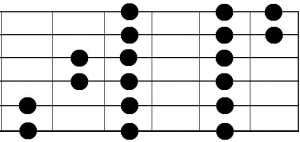Confusion about 3 Notes Per String scales
By Michael Korte
In the years that I have been teaching guitar, I have encountered a few great players already, who were stuck, because of the same mistakes and misconceptions, that occurred.
Most of the time, they have been using something resembling the 3-Note-Per-String system, but not consequently, which results in hitting a wall, which they cannot get through or over or past.
This article is written to help you understanding the basic principles behind the 3-Note-Per-String system.
The basic principle is, to assign three notes of any scale to each string and the biggest reason why you want to do this, is to get a consistent pattern of note divisions for every string, so that your picking hand can use the same motions, no matter what pattern you play somewhere on the guitar neck.
Another important reason is, that it is easily combinable with directional picking, which is a very useful way to pick with a lot of efficiency, and by that getting your playing up to speed pretty easily, compared to any other method.
To achieve maximal efficiency, some things need to be done correctly:
Fingers used by the fretting hand

First off, for all the shapes I am demonstrating here, there is one basic rule for maintaining the best posture: Keep your thumb opposed to your middle finger as a general guideline. This allows you to make the stretches more comfortable that you need for this way of playing.
There are three main shapes for diatonic scales, that your fingers can assume.
The first one looks like this:
This one is generally played with the 1st, the 3rd and the 4th finger.
The second shape looks like this:
Whenever this shape occurs, usually you should play that with your 1st, 2nd and 4th finger. At this point, do not worry about any exceptions. Later on, you will know, what those are.
The third shape is a variation of the 2nd shape, because it uses the same fingers (1, 2 and 4), but extends the first finger down one fret. It looks like this:
The way that you hold your fingers for this shape is almost exactly like in the 2nd shape, but you stretch your index finger to the next lowest fret. So, if you would fret the 2nd shape on frets 6, 7 and 9, you would keep everything as it is, but you simply move the index finger to the 5th fret, so that you have your fingers on frets 5, 7 and 9.
The Picking Hand
The biggest obstacles, guitar players can create for themselves, when they want to play with modes in the 3-Note-Per-String system, is to NOT apply directional picking but to stick to alternating picking. Sure, you can continue using it, but using directional picking and getting used to this way of playing brings you (I estimate) 30 % more efficiency.
What you need to work on, is to not let the pick stop between string changes and keeping up the momentum. A good way to practice this, is to play a scale sequence like this:
Play this really slowly and every time you have two downstrokes right after each other, try landing on the next string immediately after playing the note before the string change and only then pick the next note. Also practice this going down the scale for your upstrokes.
If you played using alternating picking for your whole life as a guitarist, this will take some time to get used to it and I recommend to not force anything in the beginning. Just play slow and get used to that. Building speed with this system requires a different approach. So, don’t rush, just get your brain to get used to the new way of playing and focus on clean movements and perfect motions.
About the author:
Michael Korte is teaching guitar in Finland. In his guitar school, he teaches his students new approaches and concepts for their rhythm and solo playing and also shows them how to improve their practicing, so that they get better results faster. If you want to reach the next level in your playing and you are looking for kitaratunnit in Tampere make sure to get in touch with him.

